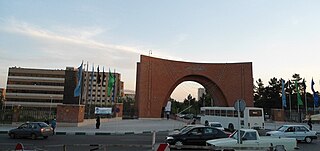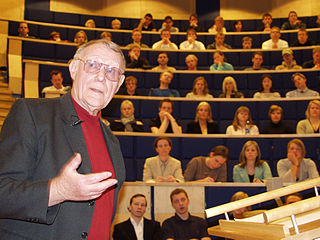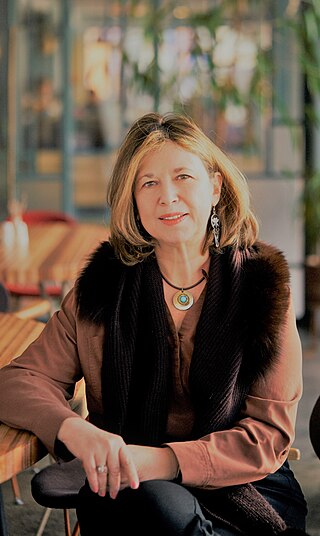
The UC Berkeley College of Chemistry is one of the fifteen schools and colleges at the University of California, Berkeley. It houses the department of chemistry and the department of chemical and biomolecular engineering, both of which are ranked among the best in the world. Its faculty and alumni have won 18 Nobel Prizes, 9 Wolf Prizes, and 11 National Medals of Science.

Tarbiat Modares University is a graduate university with its main campus in Tehran, Iran. It was founded in 1982 to train university professors and is among the top universities in Iran. Admission is through national-level university exams, and in most programs, is limited to top performers.
Carlos Simmerling is a full professor of chemistry at the State University of New York at Stony Brook. He is associate director of the Louis and Beatrice Laufer Center for Physical and Quantitative Biology. Simmerling received his Bachelor of Arts in 1991 from the University of Illinois at Chicago and then his doctorate in 1994 from the same institution. His postdoctoral work was performed at the University of California, San Francisco under the direction of Peter Kollman. His primary field of interest is computational structural biology with a focus on methods of conformational sampling and protein structure prediction. He is a member of the AMBER development team.

The Faculty of Science is the largest of six faculties at McMaster University in Hamilton, Ontario, Canada. Founded in 1962, the faculty is located in the Westdale neighbourhood. It houses 6,800 undergraduate students and 600 graduate students, across 39 upper-year undergraduate programs ranging from astrophysics, biochemistry, earth and environmental sciences, to life sciences, human behaviour, kinesiology and medical and radiation sciences. Notable discoveries at McMaster University include the development of neutron spectroscopy by Bertram Brockhouse which earned him a Nobel Prize in Physics in 1994.
At Duke University, the title of James B. Duke Professor is given to a small number of the faculty with extraordinary records of achievement. At some universities, titles like "distinguished professor", "institute professor", or "regents professor" are counterparts of this title. Two Nobel laureates currently serve as James B. Duke Professors.

The College of Natural Science (NatSci) at Michigan State University is home to 27 departments and programs in the biological, physical and mathematical sciences.

Linnaeus University (LNU) (Swedish: Linnéuniversitetet) is a state university in the Swedish historical province (landskap) Småland, with campuses located in Växjö and Kalmar. Linnaeus University was established in 2010 by a merger of former Växjö University and Kalmar University (Högskolan i Kalmar), and is named in honour of the Swedish botanist Carl Linnaeus.
The College of Science and Engineering is one of the three colleges of the University of Edinburgh. With over 2,000 staff and around 9,000 students, it is one of the largest science and engineering groupings in the UK. The college is largely located at the King's Buildings campus and consists of the separate schools of:
Henry B. Laufer is an American hedge fund manager, investor, mathematician, and philanthropist. He served as the Vice President of Research at Renaissance Technologies.
Kenneth Austin Dill is a biophysicist and chemist best known for his work in folding pathways of proteins. He is the director of the Louis and Beatrice Laufer Center for Physical and Quantitative Biology at Stony Brook University. He was elected a member of the National Academy of Sciences in 2008. He was elected to the American Academy of Arts and Sciences in 2014. He has been a co-editor or editor of the Annual Review of Biophysics since 2013.

Ivet Bahar is a Turkish-American computational biologist, currently serving as the Director of the Louis and Beatrice Laufer Center for Physical and Quantitative Biology, Louis & Beatrice Laufer Endowed Chair and Professor of Biochemistry and Cell Biology at the Stony Brook University, School of Medicine. Before joining Stony Brook University, she served as Distinguished Professor, John K. Vries Chair and Founder of the Department of Computational and Systems Biology at the University of Pittsburgh School of Medicine (2001-2022), and as Assistant (1986-1987), Associate (1987-1993) and Full Professor (1993-2001) at the Chemical Engineering Department of Boğaziçi University, Istanbul, Turkey. Dr. Bahar is also the co-founder of an internationally acclaimed Joint CMU-Pitt Ph.D. Program in Computational Biology, CPCB, offered by the University of Pittsburgh and Carnegie Mellon University. She is an elected member of the European Molecular Biology Organization (EMBO) since 2000. She was elected to the National Academy of Sciences in 2020.

The University College of Science, Technology and Agriculture are two of five main campuses of the University of Calcutta (CU). The college served as the cradle of Indian Sciences by winning the Nobel Prize in Physics in 1930 and many fellowships of the Royal Society London.
Heather J. Lynch is an associate professor of Ecology and Evolution at Stony Brook University and the first Endowed Chair for Ecology and Evolution at Stony Brook's Institute for Advanced Computational Science. She is a 2019 laureate of the Blavatnik Awards for Young Scientists and a National Geographic Explorer. Lynch uses satellite remote sensing, field work and mathematical models to better understand the population dynamics of the penguins of the Antarctic Peninsula.








